Bananas come in more than just the common yellow variety you find at supermarkets. Across the globe, there are many unique and flavorful types of bananas—ranging from tiny, candy-sweet Lady Finger bananas to the starchy, cook-friendly Plantains. Each type has its own shape, taste, texture, and ideal use.
In this guide, you’ll discover 25 different banana varieties from around the world, including where they grow, how to identify them, what they taste like, and the health benefits they offer. Whether you love eating bananas fresh, baked, or fried—there’s a perfect variety waiting to be explored.
1. Cavendish Banana
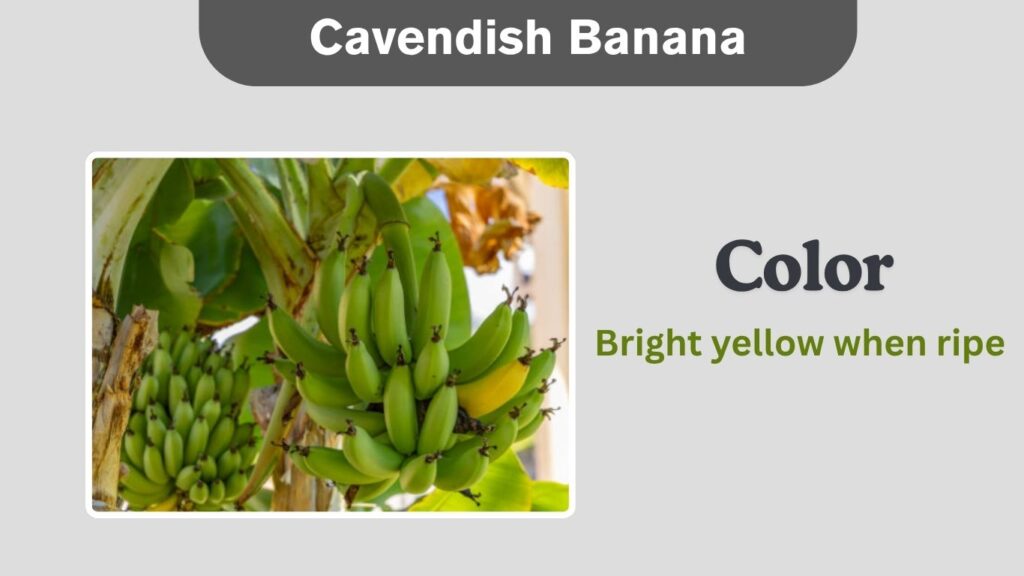
The Cavendish banana is the most common and recognizable banana variety found in grocery stores across the world. Its bright yellow skin, balanced sweetness, and soft texture make it a household favorite for both snacking and cooking. It plays a central role in global banana exports and has replaced the now-rare Gros Michel variety.
Identification
- Color: Bright yellow when ripe, green when unripe
- Shape: Slightly curved, cylindrical
- Size: Typically 6–9 inches in length
- Texture: Smooth peel with soft, creamy flesh
- Seeds: Tiny black dots within the fruit, not true seeds
Where It Grows
Cavendish bananas thrive in warm, tropical climates with well-drained soil. They are widely cultivated in countries like India, the Philippines, Ecuador, and Colombia. These nations dominate the global banana trade, supplying large volumes of Cavendish to Europe, the US, and other markets.
Taste and Culinary Use
The taste of a Cavendish banana is mildly sweet with a hint of vanilla-like smoothness. It’s not overpowering, making it suitable for all ages. The fruit is enjoyed fresh, blended into smoothies, or mashed for baking in banana breads and pancakes. Its texture holds up well in cereal bowls, oatmeal, and even as baby food.
Health Benefits
Cavendish bananas are a great source of potassium, helping to maintain heart health and proper muscle function. They also contain vitamin B6, which supports metabolism, and dietary fiber, which promotes digestive regularity. This fruit is naturally low in fat and calories, making it a healthy snack option throughout the day.
2. Red Banana

Red bananas are a unique and visually striking variety with reddish-purple skin and a sweet, creamy flesh that’s often tinged with pink or light orange. They’re generally smaller and plumper than the common yellow bananas and are prized for their rich flavor and aroma.
Identification
- Color: Reddish-purple peel when ripe
- Shape: Shorter and thicker than Cavendish
- Size: Around 4–6 inches long
- Texture: Dense, creamy flesh
- Seeds: Small dark flecks inside, not noticeable while eating
Where It Grows
Red bananas grow in tropical and subtropical regions. They are widely cultivated in India, East Africa, Southeast Asia, and Central America. In the US, they are available in specialty markets and gourmet grocery stores.
Taste and Culinary Use
Red bananas have a richer, sweeter taste than Cavendish bananas, often with subtle raspberry or mango-like notes. Their creamy texture makes them ideal for eating raw, blending into fruit bowls, or using in desserts like parfaits, puddings, and ice creams.
Health Benefits
Red bananas are high in antioxidants like beta carotene and vitamin C, which support skin health and immune function. They also provide potassium, fiber, and vitamin B6. The natural sugars offer quick energy, while the fiber helps balance digestion.
3. Lady Finger Banana
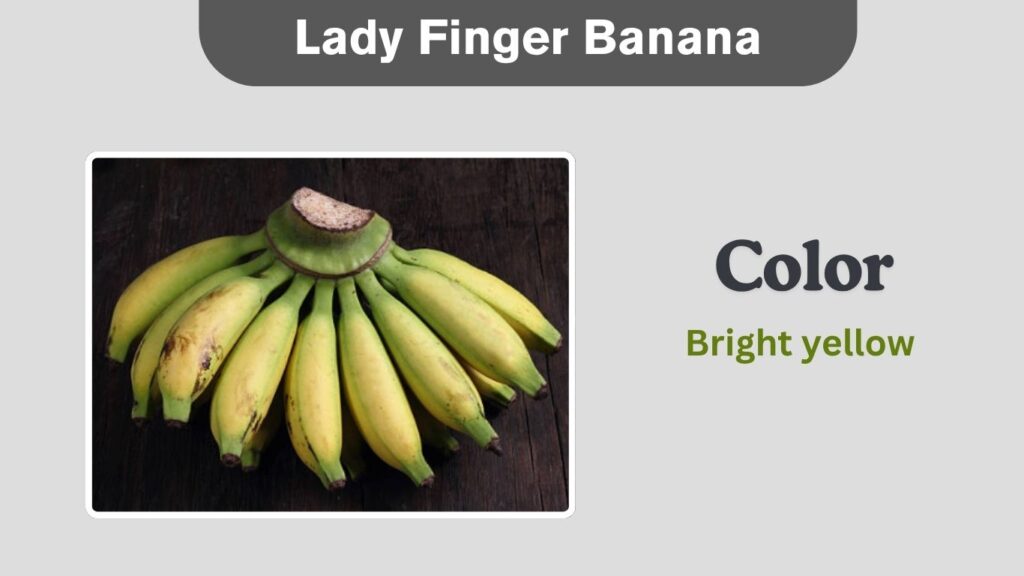
Lady Finger bananas, also known as “baby bananas” or “Sucrier bananas,” are a small, slender variety known for their intense sweetness and smooth texture. They are a favorite for children and often used in decorative fruit arrangements due to their petite size.
Identification
- Color: Bright yellow with thinner skin
- Shape: Slim and slightly curved
- Size: Typically 4–5 inches long
- Texture: Smooth and tender flesh
- Seeds: Barely visible tiny dots
Where It Grows
These bananas flourish in warm, humid climates and are grown in Australia, Southeast Asia, the Caribbean, and parts of Central and South America. They are also cultivated in backyard gardens in tropical regions.
Taste and Culinary Use
Lady Finger bananas have a strong, candy-like sweetness that sets them apart from larger varieties. They are commonly eaten fresh, added to lunchboxes, or used in banana-based desserts. Because of their small size and soft bite, they’re perfect for quick snacks.
Health Benefits
Rich in dietary fiber, Lady Finger bananas aid digestion and promote gut health. Their high potassium content supports heart and muscle function, and the natural sugars make them a good energy booster. They also contain antioxidants that help reduce oxidative stress in the body.
4. Blue Java Banana

The Blue Java banana, often called the “Ice Cream Banana,” is famous for its silvery-blue peel and soft, vanilla-like flavor. This variety is especially popular among gardeners and tropical fruit lovers due to its cold tolerance and dessert-like taste.
Identification
- Color: Silvery-blue skin when unripe, pale yellow when ripe
- Shape: Plump and curved
- Size: Typically 6–7 inches long
- Texture: Soft, creamy, ice-cream-like flesh
- Seeds: Small sterile black dots inside
Where It Grows
Blue Java bananas are mostly grown in Southeast Asia, Hawaii, Central America, and parts of Australia. They thrive in warm regions but are more cold-tolerant than most banana varieties, making them suitable for subtropical climates.
Taste and Culinary Use
Known for their vanilla flavor and creamy consistency, Blue Java bananas are often eaten raw or frozen and blended into smoothies to mimic ice cream. Their texture and taste make them a natural dessert alternative and a favorite for fruit lovers.
Health Benefits
They provide essential nutrients such as vitamin C, potassium, and magnesium. The fiber in Blue Java bananas supports digestion, while their natural sugars offer an energy lift. Their soft texture also makes them suitable for babies and people with sensitive stomachs.
5. Burro Banana

The Burro banana is a short, square-shaped variety with a tangy lemon-banana flavor. It’s denser and firmer than Cavendish, and its versatility in both sweet and savory dishes makes it popular in Latin American cuisine.
Identification
- Color: Greenish-yellow skin when ripe, with black spots
- Shape: Short and chunky with squared ends
- Size: Around 4–6 inches
- Texture: Firm flesh that softens when fully ripe
- Seeds: Minimal, tiny black specks
Where It Grows
Burro bananas are commonly grown in Mexico, Central America, and parts of the Caribbean. They do well in both humid lowlands and semi-dry tropical regions, making them versatile for a variety of climates.
Taste and Culinary Use
This banana has a lemony, tangy flavor when underripe and becomes creamy and sweet as it ripens. It’s suitable for both raw eating and cooking. People use Burro bananas in stir-fries, curries, desserts, and even grilled banana dishes.
Health Benefits
Burro bananas offer a solid amount of vitamin C and potassium. Their dense texture means they digest more slowly, helping to sustain energy. They’re also a good source of dietary fiber and natural sugars, promoting gut health and stamina.
6. Manzano Banana

The Manzano banana, also known as the “apple banana,” is a small, stubby variety with a delightful apple-strawberry flavor when fully ripe. It’s popular in Latin America and the Caribbean, especially as a fresh snack or dessert fruit.
Identification
- Color: Yellow peel with black spots when ripe
- Shape: Short and thick
- Size: Usually 3–5 inches long
- Texture: Dense and creamy flesh
- Seeds: Small black dots inside, not bothersome
Where It Grows
Manzano bananas are widely grown in Mexico, Central America, the Caribbean, and the Philippines. They thrive in tropical climates and are often found at local markets and specialty produce shops rather than large grocery chains.
Taste and Culinary Use
The flavor is rich, sweet, and tangy—similar to a mix of apples and strawberries. When underripe, they taste slightly tart. These bananas are perfect for eating fresh, making fruit salads, or using in tropical desserts and drinks.
Health Benefits
They are a great source of vitamin B6, fiber, and vitamin C. The unique balance of sweetness and acidity helps promote digestion while offering a natural energy boost. Their compact size also makes them ideal for portion control and kids’ snacks.
7. Gros Michel Banana

The Gros Michel banana, once the dominant commercial variety before the rise of the Cavendish, is known for its rich flavor, creamy texture, and superior shelf life. Although it’s not as widely cultivated today due to disease vulnerability, it’s still cherished by banana enthusiasts.
Identification
- Color: Bright yellow skin with a slight sheen
- Shape: Larger and more robust than Cavendish
- Size: Around 8–10 inches long
- Texture: Creamier and firmer flesh than modern varieties
- Seeds: Virtually seedless
Where It Grows
Gros Michel was originally cultivated on a massive scale in Central America, especially in countries like Honduras and Costa Rica. Today, it’s still grown in limited areas across Southeast Asia and parts of Africa for local consumption.
Taste and Culinary Use
It has a fuller banana flavor—sweet, creamy, and aromatic—which many people believe is superior to the Cavendish. It holds up exceptionally well in baking and transport, making it ideal for banana pies, breads, and smoothies.
Health Benefits
Gros Michel bananas are high in potassium, vitamin C, and magnesium. Their rich nutrient profile supports cardiovascular health, immune function, and energy levels. The denser flesh also provides longer-lasting satiety, making them a wholesome snack.
8. Pisang Raja Banana

Pisang Raja bananas are a beloved variety in Indonesia, especially popular for their use in fried banana snacks. They are medium-sized with golden-yellow skin and rich, honey-like sweetness, making them ideal for both fresh eating and desserts.
Identification
- Color: Golden yellow with slight blotching when ripe
- Shape: Thick and rounded with a tapering end
- Size: About 6–7 inches long
- Texture: Dense yet tender flesh
- Seeds: Minimal, soft dark specks
Where It Grows
Pisang Raja is primarily grown in Indonesia and Malaysia. It’s a staple in Southeast Asian markets and is often seen in traditional street food dishes and home cooking. The trees flourish in tropical, humid conditions with well-drained soil.
Taste and Culinary Use
This variety is known for its deep, sweet flavor with caramel undertones. It’s most famous for being used in pisang goreng (Indonesian fried banana), but it’s also delicious when eaten raw or baked into cakes and pastries.
Health Benefits
Pisang Raja bananas are rich in carbohydrates and natural sugars, providing quick energy. They also supply essential nutrients like potassium and vitamin B6. Their slightly firmer texture supports digestion and makes them more filling compared to softer varieties.
9. Goldfinger Banana

The Goldfinger banana is a hybrid variety developed for its disease resistance and excellent flavor. It has a slightly tangy taste and firm texture, making it versatile for both raw consumption and cooking.
Identification
- Color: Bright yellow when ripe
- Shape: Uniform, slightly curved
- Size: Typically 6–8 inches long
- Texture: Firm and less mushy than Cavendish
- Seeds: Practically seedless
Where It Grows
Originally developed in Honduras, the Goldfinger banana is now grown in various tropical and subtropical regions, including parts of Central America, Australia, and the Caribbean. It adapts well to different climates and soil types.
Taste and Culinary Use
Goldfinger bananas have a balanced flavor with a mild tanginess that distinguishes them from other sweet varieties. They are great for fresh eating, slicing into cereal, and grilling. Their firm texture holds up well in cooked dishes like banana fritters or banana curry.
Health Benefits
This banana is a good source of fiber, vitamin C, and potassium. Its slower-ripening flesh provides a steady energy release, making it suitable for athletes and those seeking long-lasting satiety. Its disease-resistant nature also means it’s grown with fewer chemicals.
10. Apple Banana

Apple bananas, often confused with Manzano bananas, are a sweet and tropical variety known for their fragrant aroma and tangy-apple-like taste. They’re commonly found in Hawaii and other Pacific islands and are appreciated for their rich, complex flavor.
Identification
- Color: Yellow peel with occasional brown specks when ripe
- Shape: Short, plump, and slightly curved
- Size: About 4–5 inches long
- Texture: Dense and silky flesh
- Seeds: Tiny and soft, barely noticeable
Where It Grows
Apple bananas are widely cultivated in Hawaii, the Philippines, and other parts of Southeast Asia. They thrive in volcanic soil and tropical climates and are commonly found at local markets rather than large grocery chains.
Taste and Culinary Use
These bananas have a strong, fruity aroma and a unique flavor that blends apple, pineapple, and strawberry notes. They are typically eaten fresh but are also delicious in yogurt, desserts, or smoothies. Their firm texture holds up well in tropical fruit salads.
Health Benefits
Apple bananas provide quick, clean energy due to their natural sugars. They’re rich in potassium, fiber, and antioxidants that support heart and gut health. The dense nutrient content makes them a compact and healthy snack option for both kids and adults.
11. Praying Hands Banana
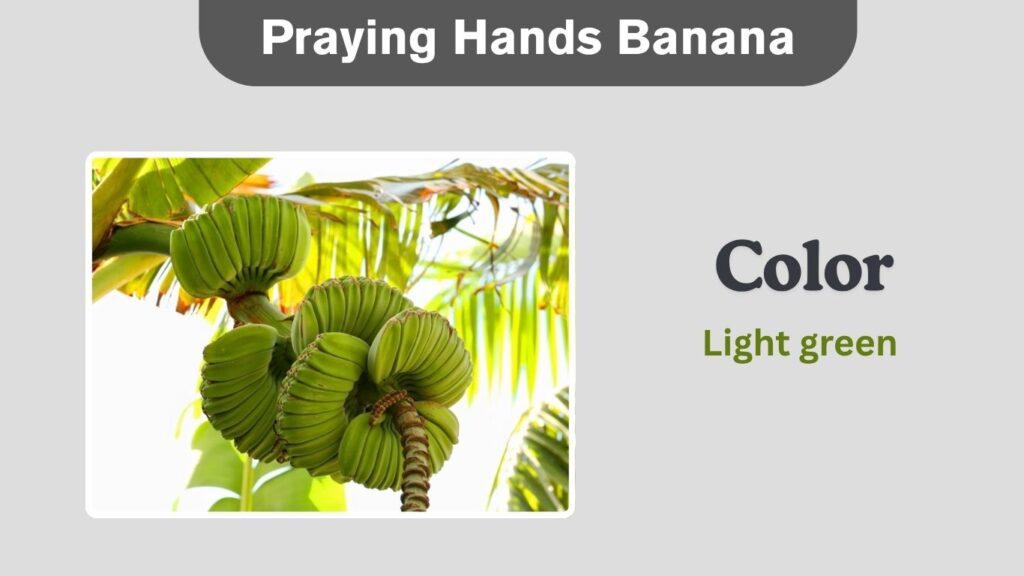
The Praying Hands banana is a visually stunning variety where two clusters of bananas fuse together, resembling a pair of hands held in prayer. Its unique appearance and mild flavor make it both a decorative and culinary novelty.
Identification
- Color: Light green to pale yellow as it ripens
- Shape: Fused double bananas with a thick structure
- Size: 6–9 inches per fused fruit
- Texture: Firm and creamy flesh
- Seeds: Sparse and soft
Where It Grows
This variety is mostly found in Southeast Asia, particularly in Indonesia and the Philippines, and is also cultivated in tropical areas of Central America. It requires warm, humid conditions and well-drained soil to thrive.
Taste and Culinary Use
Praying Hands bananas have a starchy texture when underripe and become sweeter as they ripen. They are versatile and used both fresh and cooked. In many regions, they’re steamed, grilled, or fried, but they can also be eaten raw when soft and sweet.
Health Benefits
These bananas are a good source of dietary fiber, vitamin C, and potassium. Their dense flesh keeps you full for longer, aiding weight control and digestion. They’re also commonly used in traditional diets as a natural energy source.
12. Plantain
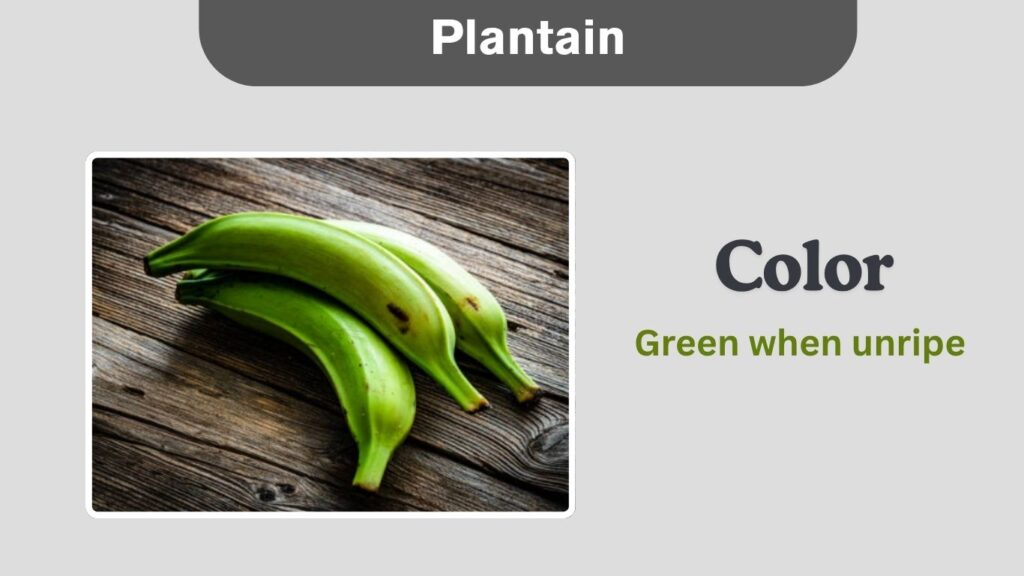
Plantains are a starchy banana variety commonly used as a vegetable rather than a fruit. Unlike sweet bananas, they are usually cooked before eating and are a staple food in many parts of Africa, Latin America, and the Caribbean.
Identification
- Color: Green when unripe, turning yellow or black when ripe
- Shape: Longer and thicker than typical bananas
- Size: Typically 8–12 inches
- Texture: Firm and starchy, softens when cooked
- Seeds: Seedless, with faint black lines inside
Where It Grows
Plantains are widely grown in tropical and subtropical regions, especially in West Africa, the Caribbean, Central and South America, and parts of Southeast Asia. They thrive in warm, humid conditions with well-drained soil.
Taste and Culinary Use
Plantains are not as sweet as dessert bananas. When green, they taste starchy and are ideal for frying, boiling, or baking. As they ripen, their flavor becomes slightly sweet. Popular dishes include fried plantains, plantain chips, and mofongo. They’re also mashed or used in stews.
Health Benefits
Plantains are rich in complex carbohydrates and dietary fiber, making them a slow-digesting energy source. They also provide potassium, vitamin A, and magnesium. Because they’re often cooked with minimal fat, they can be a healthy alternative to other starchy side dishes like potatoes.
13. Rhino Horn Banana
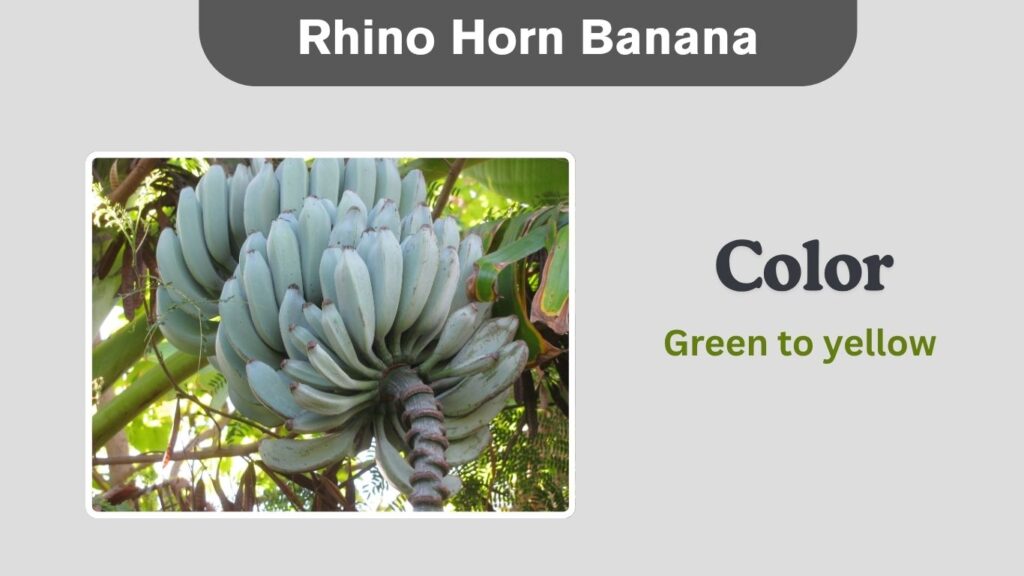
The Rhino Horn banana, also known as African Rhino Horn or Horn plantain, is one of the longest banana varieties in the world. It’s known for its striking size and versatility in cooking and ripeness stages.
Identification
- Color: Green to yellow with black spots when ripe
- Shape: Exceptionally long and curved like a horn
- Size: Can grow up to 2 feet in length
- Texture: Firm and starchy, becoming soft when ripe
- Seeds: Tiny and edible
Where It Grows
This banana is native to Africa, especially cultivated in East and Central African countries like Uganda and Kenya. It thrives in tropical climates with plenty of rainfall and sunlight and is often found in home gardens and small farms.
Taste and Culinary Use
Rhino Horn bananas can be eaten at multiple ripeness stages. When green, they are used like plantains—fried, boiled, or baked. As they ripen, they develop a sweeter flavor and can be used in desserts or enjoyed raw. Their large size also makes them a centerpiece in local dishes.
Health Benefits
These bananas offer energy-rich carbohydrates, along with dietary fiber and essential nutrients like potassium and vitamin C. Their high starch content makes them satisfying and supportive of digestive health. The variety is also valued for its long shelf life and high yield.
14. Ice Cream Banana

The Ice Cream banana, also known as Blue Java (when unripe), earns its name from its soft, creamy texture and vanilla-like flavor. It’s a popular variety among gardeners and tropical fruit lovers who enjoy unique, dessert-like fruits.
Identification
- Color: Silvery blue when unripe, pale yellow when ripe
- Shape: Medium-length, slightly curved
- Size: Around 6–7 inches
- Texture: Smooth, creamy, almost custard-like
- Seeds: Tiny black dots, not noticeable when eaten
Where It Grows
Ice Cream bananas are mainly grown in Hawaii, the Philippines, and parts of Central America. The trees are cold-tolerant compared to other banana types, making them a great choice for home gardens in subtropical climates.
Taste and Culinary Use
This banana stands out for its vanilla ice cream-like flavor. It’s typically eaten fresh or frozen and blended into smoothies or mock ice cream. The texture makes it perfect for desserts, though it can also be used in baked goods.
Health Benefits
Ice Cream bananas are rich in vitamin C, potassium, and magnesium. Their high fiber content supports digestion, and their unique texture makes them ideal for people who have trouble chewing tougher fruits. The natural sweetness offers a healthier alternative to sugary desserts.
15. Nanjangud Banana
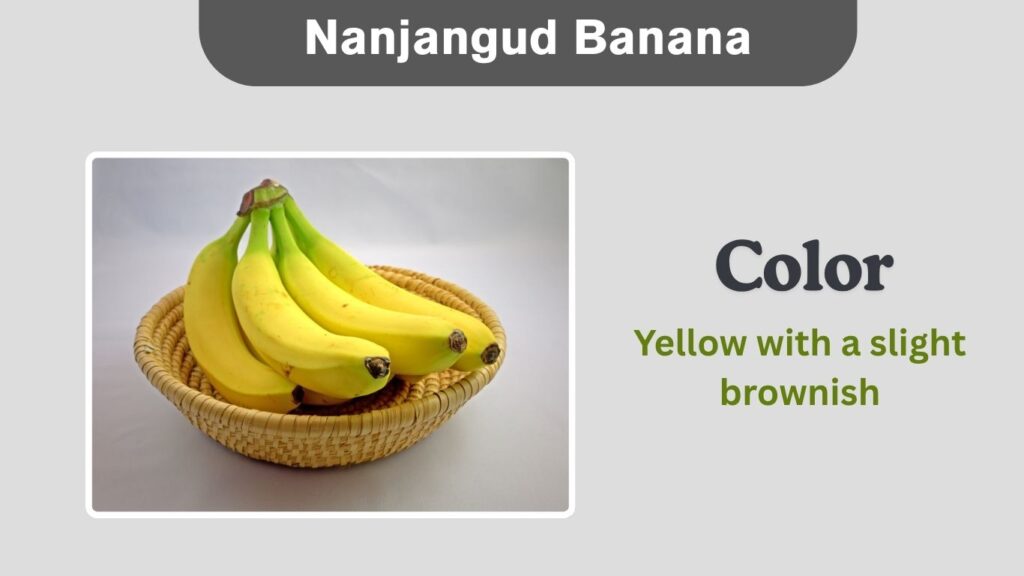
The Nanjangud banana is a specialty variety from Karnataka, India, known for its distinct aroma and geographical indication (GI) tag. It’s grown in a specific region, where the local soil and climate give it a unique flavor profile.
Identification
- Color: Yellow with a slight brownish tint
- Shape: Medium-sized, slightly curved
- Size: About 6 inches long
- Texture: Smooth and fragrant flesh
- Seeds: Barely noticeable black specks
Where It Grows
This variety is exclusive to the Nanjangud region of Karnataka, India. The unique black soil of this area contributes to the banana’s distinct taste and fragrance, making it highly valued in local markets.
Taste and Culinary Use
Nanjangud bananas are very aromatic, with a balanced sweet and sour flavor. They are mostly consumed fresh due to their exquisite taste but are also used in regional sweets and traditional South Indian dishes.
Health Benefits
These bananas are rich in iron, potassium, and natural sugars. They help improve hemoglobin levels, support heart function, and boost energy. Due to their local cultivation, they’re also free from heavy pesticide use, making them a more natural choice.
16. Mysore Banana

The Mysore banana is a popular variety from southern India, recognized for its slim shape and slightly tangy-sweet flavor. It’s commonly grown in home gardens and farms across Karnataka and Tamil Nadu and is widely consumed as a table fruit.
Identification
- Color: Bright yellow with black speckles when ripe
- Shape: Slender and slightly curved
- Size: Around 5–6 inches in length
- Texture: Soft and tender flesh
- Seeds: Tiny dark specks, not hard
Where It Grows
This banana variety thrives in the hilly regions of Karnataka and Tamil Nadu in India. It grows well in high humidity and moderate elevations, often cultivated in backyard orchards and small farms.
Taste and Culinary Use
Mysore bananas have a slightly tangy taste when compared to sweeter varieties. The flavor becomes smoother and more fragrant as the fruit ripens. They are mostly eaten raw, packed in lunchboxes, or added to local dishes like halwa and banana dosas.
Health Benefits
They are a good source of dietary fiber, iron, and vitamin B6. The fruit helps maintain digestive health and boosts energy. It’s also often recommended for individuals recovering from illness due to its light, nutritious properties.
17. Namwah Banana

The Namwah banana, also known as Pisang Awak, is a hardy and productive variety native to Southeast Asia. It’s known for its sweet flavor, dense texture, and ability to thrive in a variety of growing conditions.
Identification
- Color: Green turning to yellow as it ripens
- Shape: Plump and rounded with a short curve
- Size: Typically 5–6 inches
- Texture: Firm and starchy, softens when ripe
- Seeds: Few and very small
Where It Grows
Namwah bananas are commonly grown in Thailand, Laos, Vietnam, and also in some parts of Florida and Central America. They tolerate drought and mild cold better than many other banana varieties, making them suitable for home growers.
Taste and Culinary Use
They offer a rich, sweet flavor and can be eaten raw when ripe or cooked when green. In many Asian cuisines, Namwah bananas are steamed, grilled, or fried in dishes and desserts. They’re also used to make banana chips and traditional snacks.
Health Benefits
Namwah bananas are packed with potassium, fiber, and antioxidants. Their firm flesh is filling and great for managing hunger. The variety also supports muscle recovery and cardiovascular health, making it a good option for active individuals.
18. Lakatan Banana

Lakatan bananas are one of the most popular dessert bananas in the Philippines. They are known for their bright yellow-orange skin and sweet, aromatic flavor. Preferred over Cavendish in many Filipino households, Lakatan is often used in snacks, desserts, and festivals.
Identification
- Color: Deep yellow to orange when fully ripe
- Shape: Slightly curved and thicker than average
- Size: Around 5–7 inches long
- Texture: Smooth, soft, and creamy
- Seeds: Soft black specks, not prominent
Where It Grows
Lakatan is predominantly grown in the Philippines, especially in Luzon and Mindanao. It thrives in warm, humid tropical climates and is widely sold in local markets throughout the country.
Taste and Culinary Use
The flavor of Lakatan bananas is exceptionally sweet with a strong fruity aroma. They are usually eaten fresh but also feature in traditional Filipino desserts like banana cue, turon, and halo-halo. Their firm yet creamy texture makes them ideal for both raw and cooked recipes.
Health Benefits
Lakatan bananas are high in beta-carotene, which the body converts to vitamin A—important for eye health. They also provide vitamin C, fiber, and potassium, helping support immunity, digestion, and heart function. Their rich color indicates strong antioxidant properties.
19. Dwarf Cavendish Banana

The Dwarf Cavendish is a compact banana variety that produces full-sized fruit on a shorter plant, making it ideal for container gardening and small spaces. Despite its small stature, it yields the same sweet and familiar flavor as standard Cavendish bananas.
Identification
- Color: Green skin turning bright yellow when ripe
- Shape: Medium length with a classic curve
- Size: Fruit is 6–9 inches; plant grows only 5–8 feet tall
- Texture: Soft and creamy flesh
- Seeds: Tiny black dots, not noticeable
Where It Grows
This variety is grown in many tropical and subtropical regions, including the Canary Islands, India, and parts of Southeast Asia. It is especially popular among home gardeners and urban farmers due to its compact growth.
Taste and Culinary Use
Dwarf Cavendish bananas taste just like their taller counterpart—mildly sweet and smooth. They’re excellent for raw snacking, breakfast dishes, baking, and smoothies. Their predictable ripening and consistent quality make them a favorite in household kitchens.
Health Benefits
They are a good source of dietary fiber, vitamin B6, and potassium. The Dwarf Cavendish banana helps regulate blood pressure, support metabolism, and maintain digestive health. Its size also makes the plant easier to manage for home-based sustainable food production.
20. Kunnan Banana

Kunnan bananas are a lesser-known variety native to the southern regions of India, especially Kerala. This banana is mainly grown for local consumption and is highly valued for its medicinal benefits and natural sweetness.
Identification
- Color: Green when unripe, turning deep yellow with brown specks when ripe
- Shape: Short and slightly chubby
- Size: About 4–5 inches long
- Texture: Dense and fibrous flesh
- Seeds: Tiny black dots, soft and edible
Where It Grows
Kunnan bananas are primarily grown in Kerala and Tamil Nadu. They flourish in warm, moist tropical environments and are often cultivated in home gardens and small-scale farms for personal and local use.
Taste and Culinary Use
This variety has a natural sweetness with mild acidity. It is typically eaten raw when fully ripe and is also used in making traditional Ayurvedic preparations and herbal remedies. The firm flesh makes it suitable for light cooking or steaming in some local recipes.
Health Benefits
Kunnan bananas are considered excellent for digestion and gut health. They are used in Ayurvedic diets to improve energy, balance the body’s internal heat, and help soothe ulcers. Their high iron and fiber content also supports healthy blood levels and metabolism.
21. Saba Banana
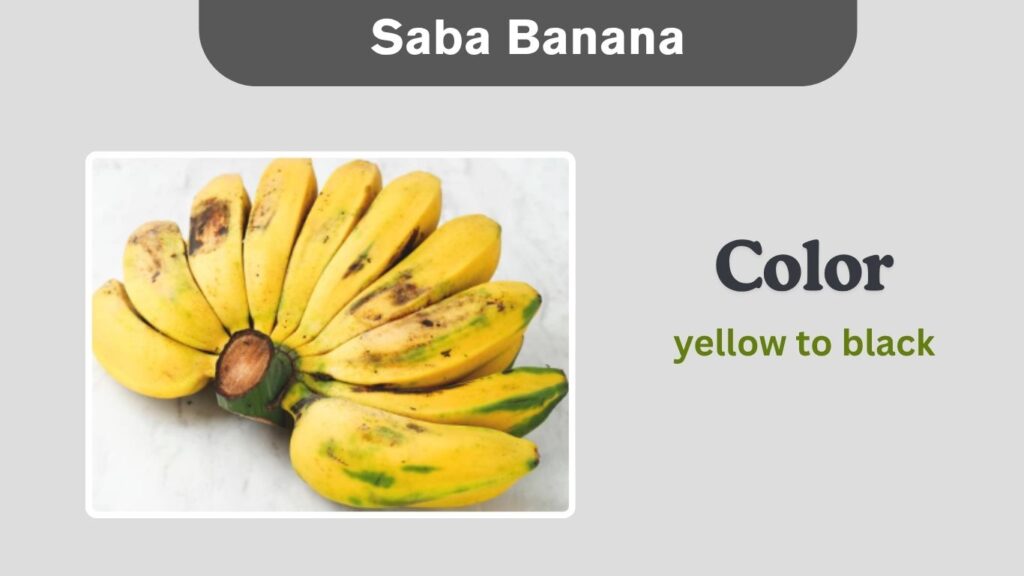
The Saba banana is a robust, thick-skinned cooking banana from the Philippines, widely used in both sweet and savory dishes. Its size and versatility have made it a staple in Filipino households and a key ingredient in various local delicacies.
Identification
- Color: Green when unripe, yellow to black when ripe
- Shape: Thick, angular, and blocky
- Size: Typically 5–6 inches long
- Texture: Firm and starchy, softens with cooking or ripening
- Seeds: Small and unnoticeable when cooked
Where It Grows
Saba bananas are extensively cultivated throughout the Philippines and also found in parts of Indonesia and Thailand. The plant is hardy and grows well in diverse soil types and weather conditions, making it ideal for tropical farming.
Taste and Culinary Use
When green, Saba bananas are neutral and starchy, perfect for boiling, frying, or grilling. As they ripen, they become sweeter and are used in Filipino dishes like banana cue, minatamis na saging, and turon. Their firm texture also makes them great for soups and stews.
Health Benefits
Saba bananas are rich in complex carbohydrates, vitamin C, and potassium. They provide lasting energy and support immune function. Because they are often consumed cooked, they can be easier to digest for people with sensitive stomachs.
22. Bluggoe Banana

Bluggoe bananas are a plantain-type variety known for their starchy, firm flesh, primarily used in cooking. Popular in Caribbean and African cuisines, they’re rarely eaten raw but are valued for their texture and ability to absorb flavors.
Identification
- Color: Green when unripe, turning yellow with black patches when ripe
- Shape: Long, thick, and straight with squared edges
- Size: Around 8–10 inches long
- Texture: Firm and dry, becomes soft when cooked
- Seeds: Tiny and sparse
Where It Grows
Bluggoe bananas are commonly grown in the Caribbean, Central America, and parts of West Africa. They thrive in warm, humid environments and are cultivated both on small farms and in home gardens.
Taste and Culinary Use
This banana has a bland, starchy flavor when unripe, making it ideal for savory dishes. It’s frequently boiled, fried, or mashed, much like potatoes. In the Caribbean, it’s used in stews, soups, and as a side dish in traditional meals.
Health Benefits
Bluggoe bananas provide a good source of dietary fiber, complex carbohydrates, and potassium. They offer slow-releasing energy, support digestive health, and are beneficial for blood sugar control when used as part of a balanced diet.
23. Pelipita Banana

Pelipita bananas are a robust plantain hybrid developed for commercial agriculture. Known for their resistance to diseases and consistent productivity, they are primarily used in cooking and large-scale food preparation.
Identification
- Color: Green skin that turns yellow or black with ripening
- Shape: Thick and angular with a broad tip
- Size: 8–11 inches in length
- Texture: Very firm when unripe, softens during cooking
- Seeds: Soft and barely visible
Where It Grows
Pelipita is widely grown in Central America, especially Honduras, and also in some parts of Asia and the Caribbean. It’s favored in plantation farming due to its hardiness and high yield.
Taste and Culinary Use
Pelipita has a mild, slightly sweet flavor when cooked. It’s not suitable for raw eating but is widely used in frying, boiling, and baking. Its uniform size and shape make it ideal for commercial processing into chips, snacks, and cooked meals.
Health Benefits
Pelipita bananas are high in energy-providing starch, fiber, and essential minerals like potassium and magnesium. Their slow-digesting carbohydrates make them suitable for sustained energy, and their resistant starch supports gut health and satiety.
24. Silk Banana

Silk bananas, also known as “Apple bananas” in some regions (distinct from Manzano), are a sweet and fragrant dessert banana variety. They are prized for their soft, silky texture and mild apple-like aroma, especially in Brazil and parts of Southeast Asia.
Identification
- Color: Bright yellow skin that browns easily when overripe
- Shape: Small, slightly curved with tapered ends
- Size: About 4–5 inches long
- Texture: Very soft and silky flesh
- Seeds: Tiny dark dots inside, not bothersome
Where It Grows
Silk bananas are grown in Brazil, the Philippines, and parts of Thailand. They thrive in tropical climates and are often cultivated in smaller-scale farms and home gardens due to their delicate nature and short shelf life.
Taste and Culinary Use
These bananas are exceptionally sweet, with a smooth, melting texture and subtle apple-like flavor. They are best eaten fresh but can also be used in fruit salads, desserts, and smoothies. Because of their delicate texture, they are not commonly cooked.
Health Benefits
Silk bananas are rich in natural sugars and potassium, making them a quick energy booster. Their soft texture makes them ideal for children and elderly individuals. They also provide vitamins B6 and C, supporting immune function and metabolism.
25. Kandarian Banana

Kandarian bananas are a rare, heirloom variety cultivated mainly in India. Known for their deep flavor, resilience, and attractive appearance, they are considered both a culinary and agricultural treasure among banana growers.
Identification
- Color: Golden yellow with a reddish blush
- Shape: Slender and gently curved
- Size: Around 5–6 inches
- Texture: Smooth, dense, and aromatic flesh
- Seeds: Present but soft and edible
Where It Grows
This variety is native to India and is mainly found in southern regions like Tamil Nadu and Kerala. It is traditionally grown using organic methods in backyard gardens and small farms, where its natural hardiness is appreciated.
Taste and Culinary Use
Kandarian bananas are sweet with a hint of floral or spice-like undertones. They’re enjoyed fresh and occasionally used in traditional Indian sweets and religious offerings. Their firm flesh also makes them suitable for drying and preserving.
Health Benefits
They are packed with antioxidants, natural sugars, and minerals. The high potassium content helps regulate blood pressure, while the dense fiber supports digestion. As an organically grown variety, they’re also free from heavy pesticide use, offering a cleaner and more natural snack.











